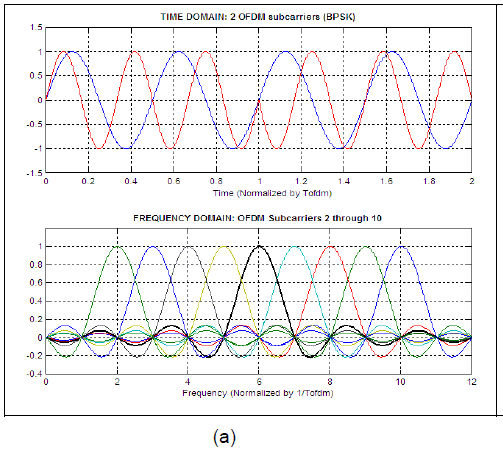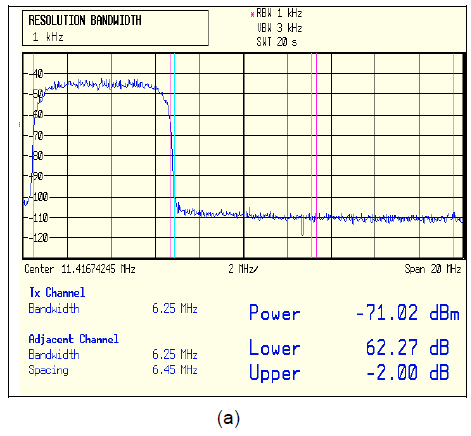New Applications Areas Driving Higher Dynamic Range Converters
1. INTRODUCTION
With the advent of higher broadband speeds in the fixed line and wireless systems, the need for higher performing data converters has become apparent. In this article, we discuss the different standards that are pushing this trend and how single tone testing, in some cases, does not accurately determine the performance in communication systems. This is particularly true in systems that employ multi-tone signalling or OFDM (orthogonal frequency division multiplexing), in which the available bandwidth is split into a large number of sub-channels, which then allows data to be transmitted over many sub-carriers, Figure 1(a), thereby enabling higher data rates.


Figure 1: a) OFDM Signal (Time and Frequency) b) OFDM output spectrum
2. 3GPP LTE
Once application driving the requirements for higher performance data converters is 3GPP Long Term Evolution (LTE). The LTE represents a major advance in cellular technology which allows higher download and upload speeds for mobile devices, thereby enabling true broadband mobile devices.
A major problem with OFDM-based systems is their high peak-to-average power ratios (PAPR), which means that the OFDM signal has a large variation between the average signal power and the maximum (or minimum) signal power. This tells us how well the signal is distributed over the amplitude range. This is why LTE has chosen Single-Carrier FDMA (SC-FDMA) as its uplink technology to overcome the challenges faced by Mobile WiMAX (802.16e) using OFDMA (Orthogonal Frequency-Division Multiple Access). But the downlink still uses pure OFDM (Orthogonal frequency-division multiplexing). LTE channel bandwidth is from 1.4-20MHz of which around 19MHz of that containing signal (whereas WiMax bandwidths are only up to 10MHz).
2.1. ADC
LTE standard could have bandwidths up to 20MHz. For reasonable filter requirements an ADC sampling rate of 40MS/s is a typical requirement irrespective of the architecture employed.
As stated earlier, OFDM is still used in the down link for the LTE application in which large PAPR is possible if all sub-carriers reach their peak amplitude simultaneously. If this occurs then this can introduce more distortion compared to single channel application [1]. This higher distortion requires the need for higher SNR in order to have same quality of performance. The number of subcarriers used in the system determines the required SNR that must be achieved. For large PAPR it is envisaged that a mobile terminal with greater then 60dB of dynamic range is required. Lower dynamic range requirement is possible if PAPR is reduced [2], but higher PAPR is required in order to improve spectral efficiency [3], thus resulting in low PA (power amplifier) efficiencies.
2.2. DAC
As mentioned previously, the LTE standard uses SC-FDMA in its uplink thereby reducing the PAPR requirement by much as 50% and maximizing the SNR requirement of the DAC [3]. As this is the case, then the same typical requirements for 802.11x and 802.16e are applicable for LTE.
3. DOCSIS
Another application driving increased data converter specifications is DOCSIS 3.0 (Data Over Cable Service Interface Specification) which gives cable modem designers the option of implementing a wideband design.
The DOCSIS downstream channel spectrum can occupy up to a 100MHz bandwidth [4] (0- 32MHz, 30-48MHz, 40-100MHz) if a wideband tuner is used instead of 4 narrow band tuners. Within this wideband of which the desired channels only constitute a fraction, the remaining undesired signals consume a substantial portion of the available signal path dynamic range.
For EuroDOCSIS the same procedure is being used with the following changes: the tones are: 5MHz, 35 MHz, and 65 MHz S-CDMA mode. Compared to the previous standard, this system requires a much higher performance ADC and DAC.
3.1. ADC
As mentioned earlier, due to the larger bandwidth the ADC sample rate needs to be well above the Nyquist (100MHz) and a clock rate >200MS/s would be required. Due to this large bandwidth, undesired signals could propagate into the spectrum this increases the requirement of the ADC SNR. In order to accommodate the additional signal power and also PAPR considerations will further increase the margin necessary in the ADC’s specifications [5].
3.2. DAC
The DAC also needs to cope with larger bandwidths and requires the SNR to increase by 6dB compared with LTE. But because of these higher bandwidths the DAC has to work at a lot higher frequencies, possibly up to 85MHz for the extended DOCSIS, which is comparably high, compared to 10-20MHz for WiMax and LTE. At these high frequencies the DAC is required to have large dynamic range.
4. DATA CONVERTER TESTING
Numerous communication systems use discrete multi-tone transmission schemes (DMT, OFDM, etc), in which the available bandwidth is split into a large number of sub-channels. Traditionally, dynamic performance of high speed data converters have been evaluated by analysing the FFT (in case of ADCs) and the output spectrum (in case of DACs) with a singletone sine-wave. But this is proving not enough in proving the data converter performance in modern communication applications. The reason for this is that the characteristics of the reconstructed multi-tone (carrier), spread spectrum are far different from that a simple, full scale sine wave.


Figure 2: OFDM signal with equally spaced at tones using different PAPR a) complete OFDM signal b) MTPR measurement in the low-band
This is why in communication systems; multi-tone power ratio (MTPR) is an important feature in the evaluation and design of DMT systems [6]. MTPR specification determines dynamic range from peak power to peak distortion, as shown in Figure 1b. As OFDM signalling scheme is used in which narrowband carriers are transmitted in parallel at different frequencies this can result in subcarriers that could potential add up to create distortion. In other words, better MTPR performance in both the transmission and receive paths results in higher data rates throughout.
In these applications, the SNR of the reconstructed waveform, which includes the effects of both noise and distortion, will directly affect the bit error rate (BER) of the system.
Another specification that has gained popularity is adjacent channel power ratio (ACPR) or adjacent-channel leakage ratio (ACLR), which is used to determine the performance of a data converter for certain applications such as DOCSIS 3.0. ACPR is the ratio of the reconstructed signal power to the power measured in an adjacent channel measured in dB. As an example, figure 2a shows single carrier spectral response for a 12-bit DAC [7], for a single carrier centered at 5MHz. The ACPR performance for a 4-carrier signal is also shown in Figure 2b.
Since the signal power level, signal bandwidth, channel spacing, carrier frequency, and data converter sampling are all application specific and affect the measurement results, the test conditions should be noted when comparing data converter IPs. The ACPR performance of a data converter is ultimately limited by its noise floor and distortion performance.


Figure 3: ACPR spectral representation a) 1 strong carrier at 5 MHz b) and containing 4 strong carriers with the first carrier at 40MHz.
References
[1] Louis Litwin and Michael Pugel, “The principles of OFDM”.
[2] Mikael Gustavsson, J. Jacob Wikner and Nianxiong Nick Tan, “CMOS Data Converters for Communications”.
[3] Tim Haynes, “Designing energy-smart 3G base stations”.
[4] Curtis Ling and Patrick Tierney, “Advances in CMIOS TV tuners make multi-tuner DOCSIS 3.0 cable modem design a reality”.
[5] Rudolf Tanner, Jason Woodward, “WCDMA – Requirements and Practical Design”.
[6] Franco Maloberti, “Data Converters”.
[8] Steve Halford, “OFDM Uncovered” S3 Mixed-Signal IP Parts Quoted in this Article:
[7] S3DA300M12BT65D
For further information:
- Email: info@s3group.com
- Website: www.s3group.com/silicon-ip
Related Semiconductor IP
- NPU IP Core for Mobile
- NPU IP Core for Edge
- Specialized Video Processing NPU IP
- HYPERBUS™ Memory Controller
- AV1 Video Encoder IP
Related White Papers
- Specifying a PLL Part 1: Calculating PLL Clock Spur Requirements from ADC or DAC SFDR
- Analog IP business not likely soon, say DAC panelists
- Outsourcing here to stay: DAC panel
- DAC panel finds IP quality lacking
Latest White Papers
- Ramping Up Open-Source RISC-V Cores: Assessing the Energy Efficiency of Superscalar, Out-of-Order Execution
- Transition Fixes in 3nm Multi-Voltage SoC Design
- CXL Topology-Aware and Expander-Driven Prefetching: Unlocking SSD Performance
- Breaking the Memory Bandwidth Boundary. GDDR7 IP Design Challenges & Solutions
- Automating NoC Design to Tackle Rising SoC Complexity